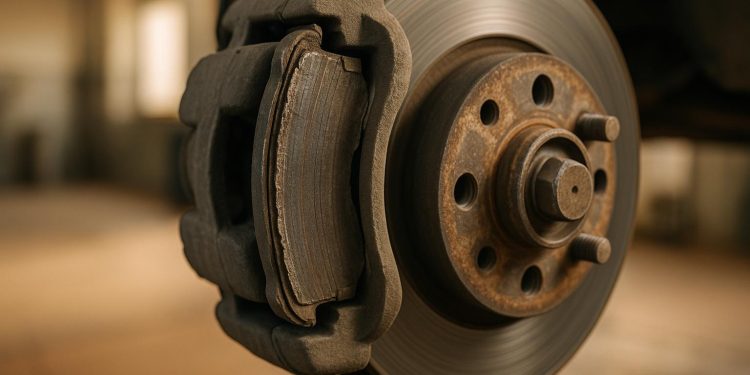Worn brake pads put your safety at risk and can lead to costly repairs if ignored. Here’s what you need to know to identify the signs early and take action:
- Noises: Squealing or grinding sounds when braking often signal worn pads.
- Performance Issues: Longer stopping distances or a soft brake pedal indicate trouble.
- Visual Clues: Pads less than 3mm thick or grooves on rotors mean replacement is due.
- Dashboard Alerts: Warning lights in modern cars can signal brake wear.
How to check: Safely lift your car, remove the wheel, and inspect pad thickness using a ruler or caliper. Pads thinner than 1/4 inch need replacing.
What happens if you delay: Ignoring worn pads can damage rotors and calipers, leading to repairs costing thousands instead of a $150–$300 pad replacement.
Regular inspections, smooth driving habits, and timely replacements can keep your brakes – and your wallet – in good shape.
SYMPTOMS OF BAD BRAKE PADS
Warning Signs Your Brake Pads Are Worn
Brake pads don’t fail without warning. Recognizing the signs early can help you avoid safety risks and expensive repairs.
Strange Noises When You Brake
Hearing squealing or squeaking sounds when you brake? That’s often the first clue. Most brake pads have built-in wear indicators – metal tabs that create this noise when the pads are thinning.
"If the act of pressing down the brake pedal results in a squeaking or squealing noise, your customer’s brake pads are likely worn past their prime and need to be replaced immediately." – Advics Marxgrp
A more alarming sound is grinding. This happens when the pads are so worn that metal parts are rubbing against each other, which can severely damage your rotors.
"Brake grinding is a grating noise that makes it clear your brakes need inspection and repair." – Bosch Auto Service
If you notice rattling or vibrations while braking, it could mean your rotors are warped or some hardware is missing due to prolonged use of worn-out pads.
But it’s not just odd noises – changes in how your brakes feel can also point to trouble.
Poor Braking Performance
If you’re experiencing longer stopping distances or a spongy brake pedal that feels soft or requires extra effort, it’s a strong sign your brake pads are worn down and compromising your ability to stop safely.
"The more worn down your brakes become, the harder it can be for them to slow and stop your vehicle (depending on how the pad wears)." – Firestone Complete Auto Care
When braking performance feels unreliable, don’t ignore it. It’s time to let a professional take a closer look.
Visual inspections can also reveal whether your brake pads are due for replacement.
What You Can See and Feel
One of the clearest indicators is brake pad thickness. You can check this by looking through your wheel spokes at the brake assembly. New pads typically measure between 8/32" and 12/32". If the pads are less than 1/4 inch thick – or about 3/32 inch – they need replacing.
Other signs include deep grooves on your rotors, visible through the wheels. These grooves mean the pads have worn down to the point of scraping the rotor surface.
In modern vehicles, dashboard warning lights may activate if brake wear sensors detect that the pads are nearing the end of their lifespan.
Be alert for brake fluid puddles under your car. While the fluid may resemble motor oil, it’s less slippery. Any leak in the brake system is a serious issue that needs immediate attention.
Lastly, check for uneven wear patterns on the brake pads. This could indicate problems with the calipers or other components that might require additional repairs.
These visible and physical signs emphasize the importance of addressing worn brake pads promptly to ensure your safety on the road.
How to Check Your Brake Pads at Home
Inspecting your brake pads at home is a practical way to stay on top of your car’s safety while saving both time and money. Regular checks can help you catch wear and tear early, avoiding costly repairs or potential safety hazards. With a few basic tools and some preparation, you can do this yourself without needing professional equipment.
Getting Your Car Ready for Inspection
The first step is to prepare your car for a safe and efficient inspection. Begin by parking on a flat, stable surface, away from any traffic. This ensures your car stays secure while you work.
Next, slightly loosen the lug nuts while the wheels are still on the ground. This makes it easier to remove the wheels later without them spinning. Then, refer to your owner’s manual to locate the recommended lifting points for your jack. Once the jack is in place, raise the car and secure it with jack stands for added safety. It’s crucial to never work under a car supported only by a jack.
After the car is safely lifted, remove the wheel completely to access the brake assembly. This will allow you to inspect the brake pads, rotors, and other components. Once exposed, you can measure the thickness of the brake pads to evaluate their condition.
Measuring Pad Thickness and Wear
To check the wear on your brake pads, start by measuring their thickness. New brake pads are usually about 10–12mm thick, so anything thinner than 3mm means it’s time to replace them for safe braking.
For precise measurements, use a caliper if you have one, though a standard ruler can work in a pinch. As Sarvesh Motihari advises, “When they’re below 3mm, it’s time to replace them for safe and effective braking”.
Make sure to measure the pad thickness at several points along the surface to ensure even wear. If the pads measure between 3mm and 5mm, keep a close eye on them and plan for a replacement soon. While they may still be functional, they’re nearing the end of their lifespan.
Tools That Help You See Better
Good visibility is key to a thorough inspection. Use a flashlight to illuminate the brake assembly, especially when examining hard-to-see areas. Proper lighting helps you spot any grooves, cracks, or other signs of damage on the brake pads or rotors.
To inspect the inside surface of the brake rotor, get into a kneeling or squatting position and use your flashlight to get a better angle. While you can do a basic check without removing the wheel, removing the wheel is recommended for a more detailed inspection. This gives you full access to all surfaces and allows for more accurate measurements.
sbb-itb-09752ea
What Makes Brake Pads Wear Out Faster
Knowing what causes brake pads to wear out faster can help you take steps to extend their lifespan and avoid unexpected repairs. Factors such as driving habits and road conditions play a big role in how quickly your brake pads wear down.
How Driving Style Impacts Brake Wear
Your driving habits have a direct impact on the lifespan of your brake pads. Aggressive driving – like hard braking, rapid acceleration, and speeding – can significantly shorten their life span. For example, hard braking can generate temperatures of up to 500°F, which, combined with frequent braking (such as in city traffic, where you might brake an average of 75,000 times a year), can quickly wear down the pads.
Stop-and-go traffic and riding the brakes also create constant friction, which increases heat and accelerates wear. If you frequently tow heavy loads or trailers, the extra weight adds even more strain on your brake system.
Speed is another major factor. Driving faster than 50 mph can wear out your brakes up to 20% quicker for every 10 mph increase in speed. To reduce wear, aim for smoother driving habits. Maintain a safe following distance, brake gradually to minimize friction, and anticipate stops to avoid sudden braking.
Adjusting your driving style can go a long way in preserving your brake pads.
Road and Weather Conditions
The type of roads you drive on and the weather you encounter can also affect your brake pads.
Driving in hilly or mountainous areas requires prolonged braking on descents, which can cause the pads and rotors to overheat. On the other hand, poor road conditions – like gravel roads, potholes, or debris-covered surfaces – can lead to more frequent and abrupt braking, accelerating pad wear.
Here’s a quick breakdown of how different driving conditions impact brake wear:
| Driving Condition | Impact on Brake Wear | Key Factors |
|---|---|---|
| City/Urban | High wear rate | Frequent braking, stop-and-go traffic, traffic lights |
| Highway | Low wear rate | Steady speeds, minimal braking, cruise control |
| Mountain/Hills | Very high wear rate | Long descents, frequent elevation changes |
| Gravel Roads | High wear rate | Debris, uneven surfaces, reduced traction |
To protect your brakes in challenging conditions, consider using techniques like engine braking or downshifting gears when driving downhill. This reduces the strain on your brake system and helps prevent overheating.
Wet roads also reduce braking efficiency, and extreme temperatures – whether hot or cold – can affect how well your brake pads perform. Adjusting your driving style to match these conditions and keeping up with regular maintenance can help you get the most out of your brakes. Being aware of when road or weather conditions are particularly tough on your brakes allows you to take preventive actions and monitor wear more closely.
What Happens When You Ignore Worn Brake Pads
Delaying brake pad replacement might seem like a way to save money, but it can lead to serious safety hazards and far more expensive repairs in the long run. Addressing worn brake pads promptly is critical to avoiding these risks and maintaining a safe, reliable vehicle.
Higher Chance of Accidents
Driving with worn brake pads greatly reduces your car’s ability to stop effectively. As the pads wear down completely, the friction between metal components increases, which can lead to overheating and even total brake failure. This not only makes your stopping distances much longer but also compromises your control during emergencies – especially on wet or slippery roads. Additionally, the constant metal-on-metal contact can cause vibrations throughout the braking system.
"Worn brakes can significantly increase stopping distances, making it harder to stop your vehicle quickly and safely." – Firestone Complete Auto Care
More Expensive Repairs Later
Ignoring worn brake pads doesn’t just put your safety at risk – it can also lead to much higher repair bills. When the pads wear down to the metal backing, they grind against the rotors, causing deep grooves, warping, or even cracks. What could have been a simple pad replacement now requires replacing the rotors entirely.
"Damage to Critical Components: Prolonged metal-on-metal grinding can warp or crack rotors, and even damage calipers, turning a simple brake service into a costly overhaul." – Firestone Complete Auto Care
The damage doesn’t stop at the rotors. Worn pads force the hydraulic piston to extend further than it should, which can lead to rust buildup and eventual caliper failure. If the calipers seize up or fail to apply pressure evenly, you’re looking at an even more expensive repair job. Uneven braking caused by worn pads can also result in premature tire wear, adding another layer of costs.
Here’s a quick look at how neglecting brake pads can escalate repair expenses:
| Component | Standard Replacement | Ignored Wear Consequence | Additional Cost Impact |
|---|---|---|---|
| Brake Pads | Replace every 30,000–70,000 miles | Metal backing grinds on rotors | Leads to rotor damage |
| Brake Rotors | Resurfacing when necessary | Deep grooves, warping, cracking | Requires full rotor replacement |
| Brake Calipers | Rarely need replacement | Piston overextension, rust buildup | Requires caliper rebuild or replacement |
Worn pads also cause overheating, leading to brake fade – a condition where the brakes lose effectiveness. This forces you to apply more pressure, further straining the system and accelerating damage. Replacing brake pads once they reach 3–4 millimeters in thickness is a much safer and more economical choice than waiting for a complete brake system overhaul.
Final Tips for Brake Pad Safety
Keeping your brake pads in good working order is essential for both safety and avoiding expensive repairs. Regular inspections and maintenance go a long way in ensuring your brakes perform when you need them most.
Plan to inspect your brake pads every 10,000 to 12,000 miles, such as during routine oil changes. Make sure the pads are at least 1/4 inch thick; if they’re thinner, it’s time to consult a professional.
"Regular inspections and maintenance are key to ensuring your vehicle’s braking system is in good working condition." – Stephen Wade Honda
Don’t overlook the condition of your brake fluid. Check its level and quality every six months, and replace it every two to three years. Dark or contaminated fluid can compromise your braking system’s effectiveness.
Pay attention to warning signs like squealing, grinding noises, vibrations, or changes in how the brake pedal feels. These symptoms often show up weeks or even months before a complete brake failure, giving you time to address the issue safely.
While self-checks are helpful, it’s wise to have a professional inspect the entire brake system every 10,000 to 15,000 miles – or at least once a year. If you drive aggressively, tow heavy loads, or navigate hilly terrain frequently, consider more frequent inspections.
Brake pads typically need to be replaced every 30,000 to 70,000 miles. Use the visual and auditory cues discussed earlier to gauge when it’s time for a replacement.
FAQs
How often should I check my brake pads to keep them in good shape?
It’s wise to check your brake pads at least once a year or every 12,000 to 15,000 miles, whichever happens first. However, if you often find yourself navigating challenging driving conditions – like constant stop-and-go traffic, steep hills, or slippery roads during wet or icy weather – you might want to inspect them more frequently.
Spotting worn brake pads early isn’t just about avoiding costly repairs; it’s also about keeping you safe while driving.
What driving habits can cause your brake pads to wear out faster?
Certain driving habits can wear down your brake pads much faster than you’d expect. For instance, hard braking, like slamming on the brakes, puts a lot of stress on the pads, causing them to wear out quickly. Similarly, frequent stop-and-go driving, especially in traffic jams, forces your brakes to work overtime, leading to faster deterioration.
Other behaviors, such as riding the brake pedal (resting your foot lightly on it while driving) or waiting until the very last moment to stop, can also take a toll on your brake pads. To make them last longer, aim for smooth, gradual braking and keep a safe distance from the car ahead to avoid unnecessary stops.
Is it safe to replace my brake pads at home, and what tools do I need?
Yes, you can replace your brake pads at home as long as you take the necessary precautions and have the right tools. You’ll need safety glasses, a dust mask, wrenches, a ratchet and socket set, and possibly Allen or Torx wrenches. Before you begin, ensure your vehicle is securely lifted and supported with a jack and jack stands.
If you’re new to car repairs, it’s a good idea to consult your vehicle’s manual and make sure you’re working on a stable, level surface. Take your time and work carefully – your safety and the quality of the repair depend on it.
Related posts
- Car maintenance costs in South Africa
- 10 Easy Car Maintenance Tips for South African Roads
- When to Replace Your Tyres – South Africa’s Guide
- Engine Light On? What It Could Mean in SA Conditions





